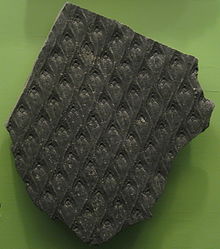
Back نبات حرشفي Arabic Lepidodendron Catalan Lepidodendron CEB Skæltræ Danish Lepidodendron German Lepidodendron Spanish پولکدرخت Persian Lepidodendron Finnish Lepidodendron French Leipididéandran Irish
| Lepidodendron Temporal range:
| |
|---|---|

| |
| Trunk fragment, showing leaf base scars | |
| Scientific classification | |
| Kingdom: | Plantae |
| Clade: | Tracheophytes |
| Clade: | Lycophytes |
| Class: | Lycopodiopsida |
| Order: | †Lepidodendrales |
| Family: | †Lepidodendraceae |
| Genus: | †Lepidodendron Sternberg, 1820 |
| Species | |
| |
| Synonyms | |
| |
Lepidodendron is an extinct genus of primitive lycopodian vascular plants belonging the order Lepidodendrales. It is well preserved and common in the fossil record. Like other Lepidodendrales, species of Lepidodendron grew as large-tree-like plants in wetland coal forest environments. They sometimes reached heights of 50 metres (160 feet),[1] and the trunks were often over 1 m (3 ft 3 in) in diameter. They are often known as "scale trees", due to their bark having been covered in diamond shaped leaf-bases, from which leaves grew during earlier stages of growth. However, they are correctly defined as arborescent lycophytes. They thrived during the Carboniferous Period (358.9 to 298.9 million years ago), and persisted until the end of the Permian around 252 million years ago. Sometimes erroneously called "giant club mosses", the genus was actually more closely related to modern quillworts than to modern club mosses. In the form classification system used in paleobotany, Lepidodendron is both used for the whole plant as well as specifically the stems and leaves.
© MMXXIII Rich X Search. We shall prevail. All rights reserved. Rich X Search